If you’re tired of endless isolation bicep exercises (bicep curls) and want to gain serious size and strength, you should add compound exercises to your bicep workout.
But why are compound bicep exercises so important?
Compound exercises effectively train both heads of the biceps brachii (the long head and short head) while simultaneously activating multiple muscle groups. They’re a great way to boost your metabolism and burn more calories.
I will share some of my favorite (based on science and experience) bicep compound exercises to help you build stronger, more defined arms.
Let’s refresh our knowledge to train biceps effectively.
Want to take your gains to the next level? Discover your daily calorie needs with our free TDEE calculator
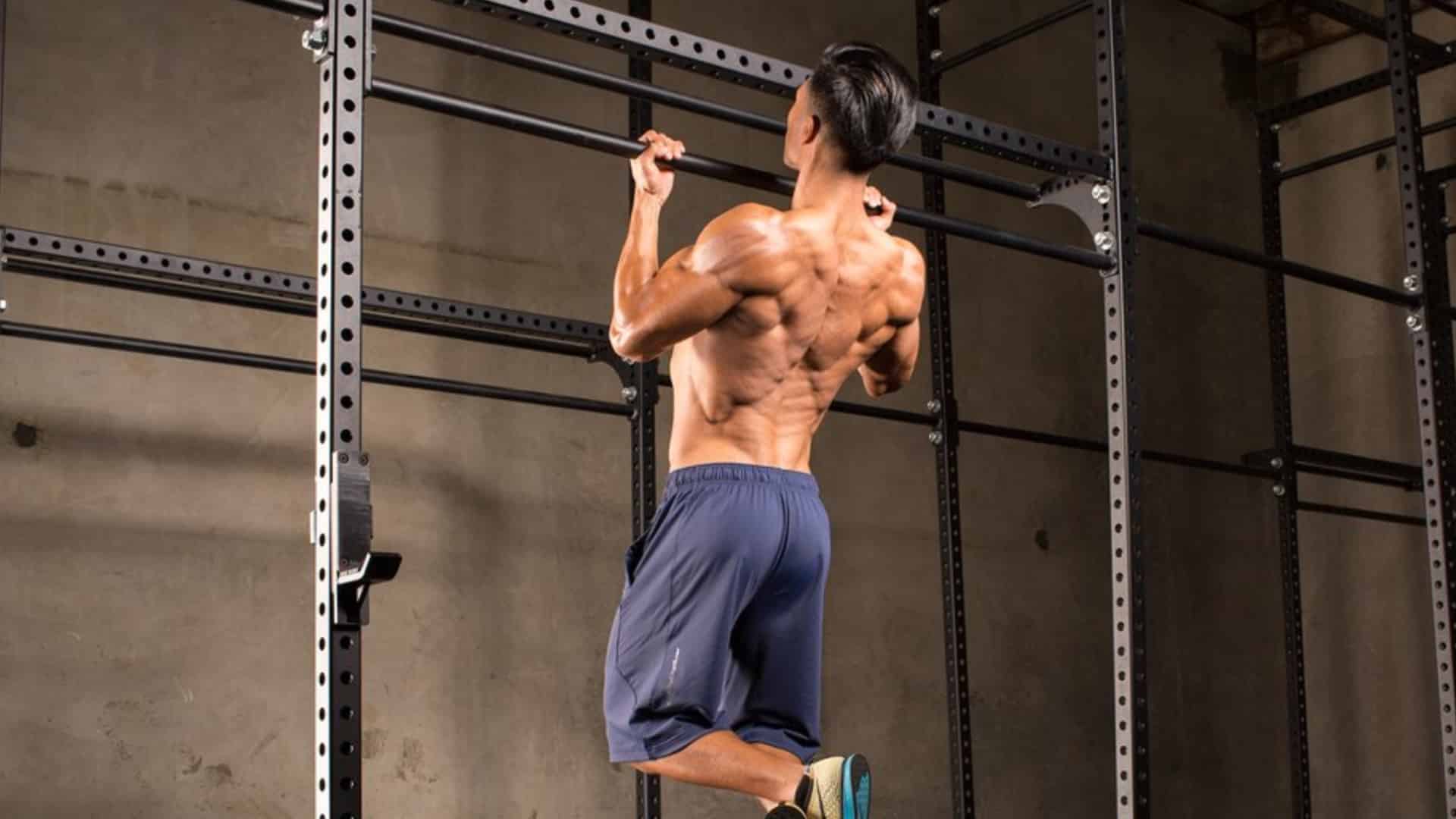
- The Best Compound Bicep Exercises
- 1. Pull-Up
- 2. Chin Up
- 3. V Bar Lat Pulldown
- 4. One-Arm Dumbbell Row
- 5. Seated Cable Row
- 6. Bent Over Barbell Row
- 7. Inverted Row
- 8. One-Arm Lats Pulldown
- 9. Isometric Chin-ups
- 10. Barbell Deadlift
- Why Should You Do Compound Bicep Over Isolation Exercises?
- 1. Improve Hypertrophy
- 2. Greater Overload
- 3. Time-Tested Results
- 4. Variety
- 5. Hormonal Response
- Compound Biceps Workout Routines
- 1. Select Your Training Goals
- 2. Workout Splits
- 3. Bicep-Focused Workout Routine
- 4. Pull Workout Routine
- 5. Full-Body Workout Routine
- FAQ’s
- What is the best compound exercise for biceps?
- Is the bicep curl a compound exercise?
- Takeaway
The Best Compound Bicep Exercises
Here are 10 of the best compound bicep exercises to build muscle mass and strength. You’ll benefit more if you introduce compound exercises into your routine that also work your biceps.
1. Pull-Up
The pull-up is an upper-body strength exercise that targets your back and bicep. Pull-ups are a challenge for beginners and experienced athletes.
It increases the strength, thickness, and width of your back, specifically your lats. The lats widen the back and form the “V” in the upper back.
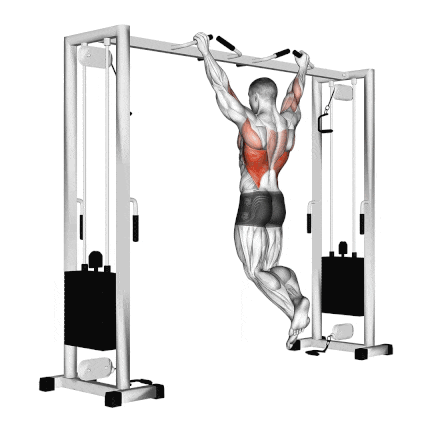
How To Do
- Grab onto a pull-up bar with your hands wider than shoulder-width apart, using an overhand grip.
- Hang from the bar with your arms fully extended and your chest high while exaggerating the arch in your lower back.
- Pull yourself up by squeezing your shoulder blades together and contracting your lats until your chin passes the bar.
- Hold the contraction at the top for a second before slowly lowering yourself back to the starting position.
2. Chin Up
The chin-up is a strength training exercise. This bodyweight exercise can induce serious muscle growth of the biceps and back.
In this exercise, the palms are faced towards the body. Since the lifter is pulling body weight, the biceps are usually exposed to loads heavier than one can lift with a barbell.
You must add this compound bicep workout to your bicep exercise arsenal.
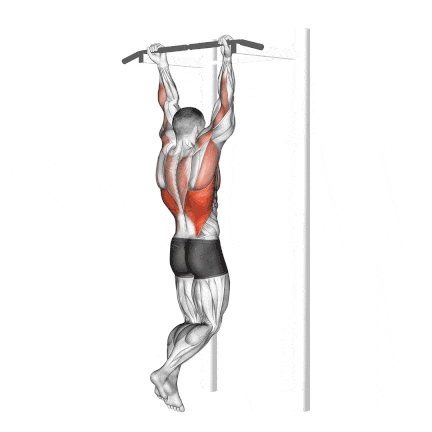
How To Do
- Grasp a pull-up bar with an underhand grip, hands shoulder-width apart or slightly narrower.
- Straighten your arms, keep your knees bent, and cross your lower legs.
- Retract your shoulder blades and pull your body until your chin aligns with the bar.
- Pause at the top for one to two seconds, with the biceps under maximum tension.
- Slowly lower to the start position.
- Don’t get in the habit of doing half-reps and chasing numbers. Lower to almost full extension of the elbow, but avoid locking out completely.
3. V Bar Lat Pulldown
The V-grip lat pulldown is a variation of the lat pulldown and an exercise used to build the back muscles. While it primarily targets the back, you will also notice a fair amount of bicep and middle back activation.
The neutral grip (palms facing one another) of the V-Bar promotes elbow flexion, which is a key function of the biceps brachii.
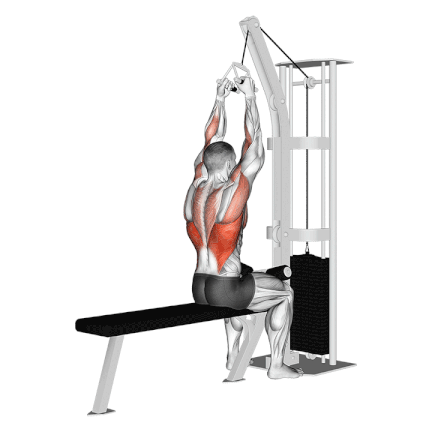
How To Do
- Attach a V handle to the high pulley of a lat-pulldown station.
- Grab the handles with your palms facing each other and position yourself on the seat with your knees under the pads.
- Keep your upper back straight, pull the V handle down, and bring it up to the chest.
- Perform this movement using your upper lats and use the arms as a lever between the handle and lats.
- Now, release the bar with controlled motion and stretch your legs as much as possible.
- Go full range of motion and concentrate on your back muscles doing the major work.
4. One-Arm Dumbbell Row
One-arm dumbbell Rows are an excellent alternative to barbell rows. They provide a full-range motion to build the lat muscles.
This exercise helps work on each side independently, providing better muscle isolation and a longer range of motion. This exercise is done with a heavy dumbbell with your body supported by a bench.
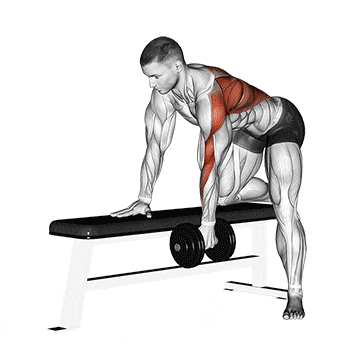
How To Do
- Grasp a dumbbell with the palm facing in.
- Rest the opposite hand and knee on a bench.
- Keep your spine straight. Avoid hunchback bending as it leads to Injury.
- Pull the dumbbell vertically upward alongside your torso, raising the elbow as high as possible.
- Slowly lower the dumbbell as low as possible, feeling a good lats spread.
- Repeat on the other side.
5. Seated Cable Row
This cable row variation presents a unique challenge to the lats. It can help you break through plateaus and take your back development to the next level.
Seated Cable Rows are an excellent cable exercise to build middle back muscles on lower lats and biceps. This works on the lower back as well.
You can use the following attachments to train the bicep and back effectively.
- V-Handle/Close-Grip Triangle.
- Kobo Low Row Close Grip.
- Short straight bar
- Rope with two ends
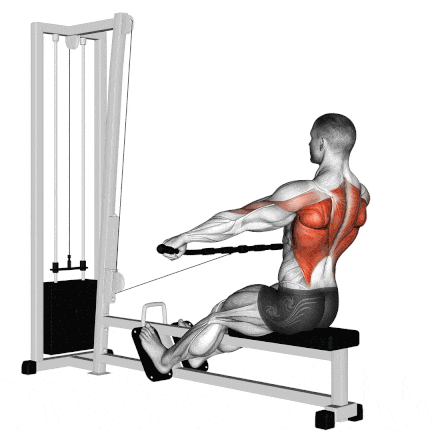
How To Do
- Sit on a seated cable pulley rowing machine with knees slightly bent to avoid knee and lower back pressure.
- Take hold of the handles with your arms extended and back stretched.
- Pull the handles to come as close to the lower chest/abdomen as possible.
- Pause briefly when the handles are close to the chest and squeeze your upper back muscles, bringing the scapulae closer.
- Slowly return the handle to the starting position.
- Remember, a rounded back is a wrong back. Keep it straight at all times.
6. Bent Over Barbell Row
The bent-over barbell rows are a great way to build serious muscle in the upper back and biceps. And the science backs it up.
Unlike isolation exercises, the bent-over row works for multiple muscle groups simultaneously, leading to greater muscle building and calorie burning.
Try different grip widths, dumbbell rows, seated cable rows, or inverted rows for added variety.
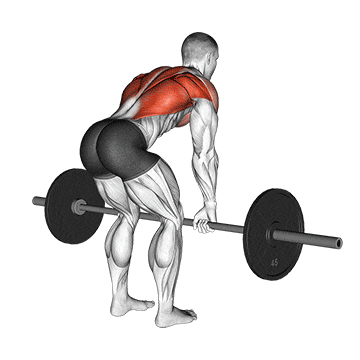
How To Do
- Stand hip-width apart.
- Grab the barbell with an overhand grip and hands shoulder-width apart.
- Keep your back straight and your core tight as you bend forward.
- Keep your upper arms close to your body as you pull the bar towards your chest.
- Slowly lower the bar back down to the starting position.
- Do 8–12 repetitions for 3–5 sets.
7. Inverted Row
The inverted row (bodyweight rows) creates a horizontal body position, making it easier to perform. It works the back and shoulder muscles from a different angle and improves upper body strength.
Most people use the Smith machine in the gym for this exercise. You can also do the inverted row at home by lying under a chair and pulling yourself up.
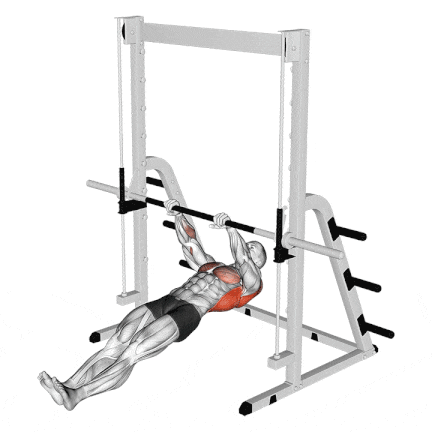
How To Do
- Adjust the height of the chair and bar so that it’s a little higher than arm’s length from the floor.
- Lie under the bar with your legs and body straight. Grasp the bar with an overhand grip that’s a little wider than shoulder width.
- Keep your legs straight and pull your chest up to the bar.
- Hold for a count of two and squeeze your back muscles.
- Breathe as you lower your body until your arms and shoulders fully extend. Repeat.
8. One-Arm Lats Pulldown
The one-arm lat pull-down is a unilateral exercise that primarily targets the latissimus dorsi, commonly known as the lats. The secondary muscle worked during it is the bicep.
It is helpful to perform the exercise unilaterally to identify and address any muscular imbalances between the left and right sides of the back and bicep.
I believe it promotes equal development and enhances overall strength and stability.
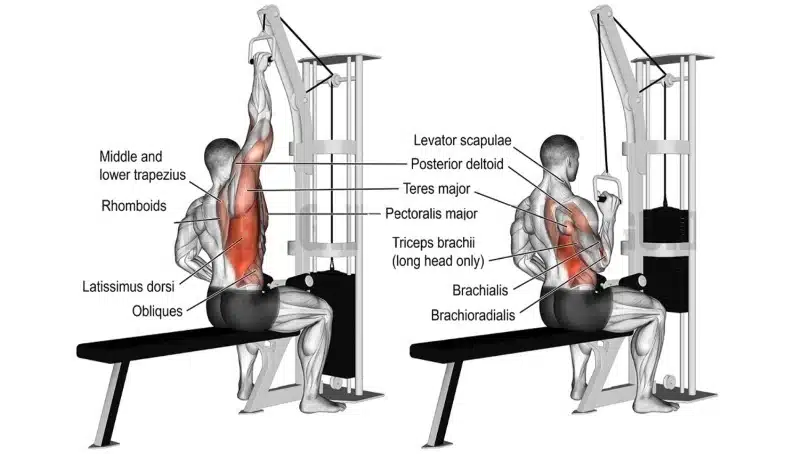
How To Do
- Attach a handle or grip to the pulley.
- Lock your knees under the support pads.
- Grasp the handle with one hand and extend your arm overhead.
- Pull the handle down and back towards the side of your torso.
- Slowly return the handle to the starting position.
- Perform a desired number of repetitions on one side before switching to the other arm.
9. Isometric Chin-ups
The Isometric (Iso) means there is no lengthening or shortening of the musculature, simply striving to maintain one shape.
Isometric holds for biceps: Imagine holding bags of groceries in your hands with your elbows bent at 90 degrees. Your biceps are fully flexed in this position.
These are simple and effective compound bicep exercises. Give it a try.

How To Do
- Grab the pull-up bar with your palms facing you and your hands about shoulder-width apart.
- Pull yourself until your chin is over the bar. If you cannot do a chin-up, you can still do this exercise by using a chair or step to jump.
- Make sure your chin is above the bar. Hold for 5 seconds, then lower to 90 degrees and hold for 5, then lower down again to just before the bottom.
- Repeat for the desired number of reps.
10. Barbell Deadlift
Research indicates compound lifts like the deadlift can stimulate muscle growth in the biceps, especially for beginners. As the body adapts to heavier weights, the biceps will continue to develop alongside other muscle groups.
The barbell deadlift is primarily a compound exercise that targets the posterior chain, including the glutes, hamstrings, and lower back and arm muscles.
During the deadlift, you must tightly grip the barbell. This gripping action engages the biceps, particularly the brachialis and brachioradialis.
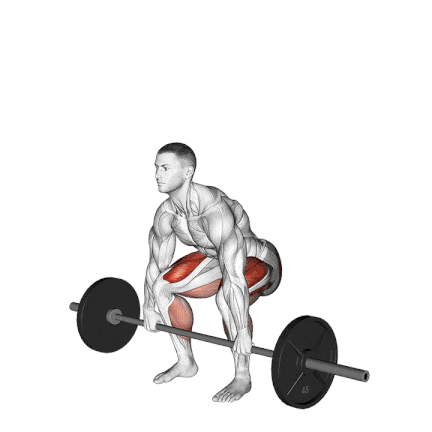
How To Do
- Move the bar towards your feet so that it is in the middle. Your feet should be about hip-width apart.
- Bend at the hip and hold the bar with your shoulders retracted.
- With your feet and grip set, take a big breath, lower your hips, and flex your knees until your shins contact the bar. Look forward with your head.
- Keep your chest up and your back arched, and begin driving through the heels to move the weight upward.
- After the bar passes, the knees, aggressively pull the bar back, pulling your shoulder blades together as you drive your hips forward into the bar.
- Lower the bar by bending at the hips and guiding it to the floor.
Why Should You Do Compound Bicep Over Isolation Exercises?
1. Improve Hypertrophy
Compound bicep exercises are multijoint activities that target multiple muscle groups and involve two or more joints.
When you do compound workouts, you’re working more muscle groups, and you can also push yourself harder. Furthermore, the utilization of heavier weights results in faster results. Compound bicep exercises include pull-ups, and rows.
For example, when you are doing a pull-up, the back is the main targeted muscle. However, many other Synergistic and stabilizer muscles, such as the Biceps brachii, rear deltoid, and traps, act in this motion.
This meta-analysis found compound exercises were more effective at building muscle mass than isolation exercises.
2. Greater Overload
By using bigger muscle groups, you can lift heavier weights and get more mechanical tension to grow muscles. Compound bicep exercises are excellent for progressively increasing the weight you lift.
A short, intense compound workout can pack a lot of muscle work into a short time, saving gym time.
3. Time-Tested Results
Many renowned bodybuilders and strength athletes emphasize the importance of compound movements. If you’re serious about building substantial bicep size and strength, these exercises have stood the test of time.
4. Variety
A mix of compound bicep exercises can add variety to your routine and prevent boredom. This variety keeps your workouts interesting and prevents plateaus as your muscles constantly adapt to new challenges.
5. Hormonal Response
Compound exercises, including compound bicep movements, can stimulate a more significant release of muscle-building hormones, such as testosterone and growth hormone.
This hormonal response contributes to muscle growth and improved body composition.
Know More Daily calories Requirement To Build Arms
Compound Biceps Workout Routines
1. Select Your Training Goals
Some people prefer to perform exercises for strength, while others are more interested in workouts for building muscle.
Again, the different training goals will mostly affect the number of reps, sets, and weights performed for the bicep workouts.
Strength and muscle mass training have many similarities but also some differences. In this bicep workout, you will target both types of gains.
- Strength training involves lifting heavy weights. Powerlifters and weightlifters routinely train with weights in the 1–6 repetition range (>85% of 1RM). Although higher rep ranges (less than 6 reps) have also been proven effective for strength gains.
- You will obtain the best muscle growth in the range of 6–12 reps per set (~60–85% of 1RM).
- For endurance, do the 15 to 20+ reps
2. Workout Splits
You can use numerous workout splits involving a “back and biceps day.” However, they would all fall into one of two categories.
- As a standalone exercise: Do 3–4 sets of 8–12 reps.
- A body part split: Workout routines that train related muscle groups on separate days.
- A Push Pull Legs split: Workout routines that train related muscle groups on the same day.
You can use this with any other program you have.
3. Bicep-Focused Workout Routine
| Exercise | Sets | Reps |
|---|---|---|
| Pull-Ups | 3-4 | 8-12 |
| Chin-Ups | 3 | 10-12 |
| One-Arm Dumbbell Row: | 3 | 8-10 |
4. Pull Workout Routine
| Exercise | Sets | Reps |
|---|---|---|
| Pull-Ups | 3 | 8-10 |
| Plank | 3 | 8-12 |
| Lats Pulldowns | 3 | 10-12 |
| Dumbbell Curl | 3 | 8-12 |
| Dumbbell Shrugs | 3 | 8-12 |
5. Full-Body Workout Routine
| Exercise | Sets | Reps |
|---|---|---|
| Squats | 3-4 | 8-10 |
| Bench Press | 4 | 6-8 |
| Deadlifts | 3 | 8-12 |
| Dumbbell Curl | 3 | 8-10 |
| Overhead Press | 4 | 8-10 |
| Lunges | 3 | 8-12 |
| Plank | 3 | 30 sec |
FAQ’s
What is the best compound exercise for biceps?
Here are the 10 best compound exercises for the biceps.
- Pull-Up
- Chin Up
- One-Arm Lats Pull-Down
- Isometric Chin-ups
- One-Arm Dumbbell Row
- Seated Cable Rows
- Bent-Over One-Arm Cable Pull
- V-Grip Lats Pull Down
- Bent Over Barbell Rows
- Inverted Row
- Bonus: Seated Row with Resistance Bands
Is the bicep curl a compound exercise?
No, the bicep curl is not a compound exercise. It is an isolation exercise that targets just the biceps brachii muscle in the front of the upper arm. The bicep curl is done by flexing at the elbow to lift a weight upwards without moving or engaging other muscles.
Takeaway
These compound bicep exercises are highly recommended for anyone interested in building bigger biceps and who wants to gain strength.
I hope this will motivate you to vary your biceps training by adding more compound exercises that work your biceps. The results will speak for themselves if you consistently do these biceps compound exercises.
Thanks for reading.

Manish is a NASM-certified fitness and nutrition coach with over 10 years of experience in weight lifting and fat loss fitness coaching. He specializes in gym-based training and has a lot of knowledge about exercise, lifting technique, biomechanics, and more.
Through “Fit Life Regime,” he generously shares the insights he’s gained over a decade in the field. His goal is to equip others with the knowledge to start their own fitness journey.
